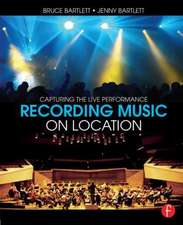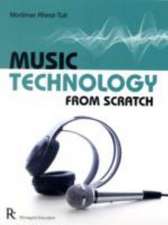Music Production: Recording: A Guide for Producers, Engineers, and Musicians
Autor Carlos Lellisen Limba Engleză Hardback – 29 aug 2017
| Toate formatele și edițiile | Preț | Express |
|---|---|---|
| Paperback (1) | 429.25 lei 6-8 săpt. | |
| Taylor & Francis – 19 apr 2013 | 429.25 lei 6-8 săpt. | |
| Hardback (1) | 1021.70 lei 6-8 săpt. | |
| Taylor & Francis – 29 aug 2017 | 1021.70 lei 6-8 săpt. |
Preț: 1021.70 lei
Preț vechi: 1370.62 lei
-25% Nou
Puncte Express: 1533
Preț estimativ în valută:
195.53€ • 202.58$ • 163.18£
195.53€ • 202.58$ • 163.18£
Carte tipărită la comandă
Livrare economică 21 martie-04 aprilie
Preluare comenzi: 021 569.72.76
Specificații
ISBN-13: 9781138469013
ISBN-10: 1138469017
Pagini: 368
Dimensiuni: 189 x 246 x 34 mm
Greutate: 0.84 kg
Ediția:1
Editura: Taylor & Francis
Colecția Routledge
Locul publicării:Oxford, United Kingdom
ISBN-10: 1138469017
Pagini: 368
Dimensiuni: 189 x 246 x 34 mm
Greutate: 0.84 kg
Ediția:1
Editura: Taylor & Francis
Colecția Routledge
Locul publicării:Oxford, United Kingdom
Public țintă
Professional Practice & DevelopmentNotă biografică
Carlos Lellis holds an SAE/Middlesex University MA in Creative Media and a diploma Summa Cum Laude from Berklee College of Music. He has worked as an engineer and producer with artists such as Rosabella Gregory, Joby Talbot and Grammy Award winners Sir John Tavener and Thomas Dybdahl amongst many others. He is currently the head lecturer at SAE Institute, London, where he oversees the first year of the BA/BSc programme in Sound Production.
Cuprins
Introduction
Why record?
1 - The Recording Environment
Traditional recording studios
Residential studios
Home studios
2 -The Recording Team / Roles and Responsibilities
Musicians
Programmers
Tape Op / Pro Tools Operator / Assistant engineer
Main Engineer
Producer
A&R and Other Record Company Representatives
Investors
3 -Preparing to record (Pre-Production)
Before Getting into the Studio
Referencing
'Demo fever'
The 'reccie'
Instrumentation / Types of audio signals
Other signals e.g. MIDI
The gear list / the sound-check chart
4 -The Tools
Microphones
Direct injection boxes
Cables / Connectors
Microphone preamplifiers
EQ
Dynamic processors
Consoles
Patchbays
Effects
Multi-Track Recorders
Two-Track Recorders
The monitoring system - Amps, speakers, headphones
5 -The Live Room (In The Studio)
Problematic environments
Power and distribution
6 -The Session
Music theory primer - Engineering requirements (transcription examples)
Musicians and equipment (instruments / microphone stands / placement)
6 -The Session
Music theory primer - Engineering requirements (transcription examples)
Musicians and equipment (instruments / microphone stands / placement)
Interplay and interaction
The sound-check
Gain structure
Polarity
Click-tracks
The 'Cue Mix' (including effects)
Studio psychology
Simultaneous tracking
Stereo Microphone Techniques
Overdubs
The auditioning process
The Monitor Mix
Recording direct to 'two-track'
Session notes / Track sheets
Recall sheets
The production progress chart
Meeting the deadline
7 -Sound Examples
8 -Appendices
9 -Outro
Why record?
1 - The Recording Environment
Traditional recording studios
Residential studios
Home studios
2 -The Recording Team / Roles and Responsibilities
Musicians
Programmers
Tape Op / Pro Tools Operator / Assistant engineer
Main Engineer
Producer
A&R and Other Record Company Representatives
Investors
3 -Preparing to record (Pre-Production)
Before Getting into the Studio
Referencing
'Demo fever'
The 'reccie'
Instrumentation / Types of audio signals
Other signals e.g. MIDI
The gear list / the sound-check chart
4 -The Tools
Microphones
Direct injection boxes
Cables / Connectors
Microphone preamplifiers
EQ
Dynamic processors
Consoles
Patchbays
Effects
Multi-Track Recorders
Two-Track Recorders
The monitoring system - Amps, speakers, headphones
5 -The Live Room (In The Studio)
Problematic environments
Power and distribution
6 -The Session
Music theory primer - Engineering requirements (transcription examples)
Musicians and equipment (instruments / microphone stands / placement)
6 -The Session
Music theory primer - Engineering requirements (transcription examples)
Musicians and equipment (instruments / microphone stands / placement)
Interplay and interaction
The sound-check
Gain structure
Polarity
Click-tracks
The 'Cue Mix' (including effects)
Studio psychology
Simultaneous tracking
Stereo Microphone Techniques
Overdubs
The auditioning process
The Monitor Mix
Recording direct to 'two-track'
Session notes / Track sheets
Recall sheets
The production progress chart
Meeting the deadline
7 -Sound Examples
8 -Appendices
9 -Outro
Descriere
Improve the artistry of your productions with this techniques guide, which focuses throughout on musicality and how your decisions affect it. Author Carlos Lellis Ferreira walks you through the recording process, bringing aesthetic considerations into each discussion. Learn visually with detailed diagrams and clear explanations of best practices.









![Sound Reinforcement Handbook: The Life and Music of Legendary Bassist James Jamerson [With 2]](https://i0.books-express.ro/bt/9780881889000/sound-reinforcement-handbook.jpg)










